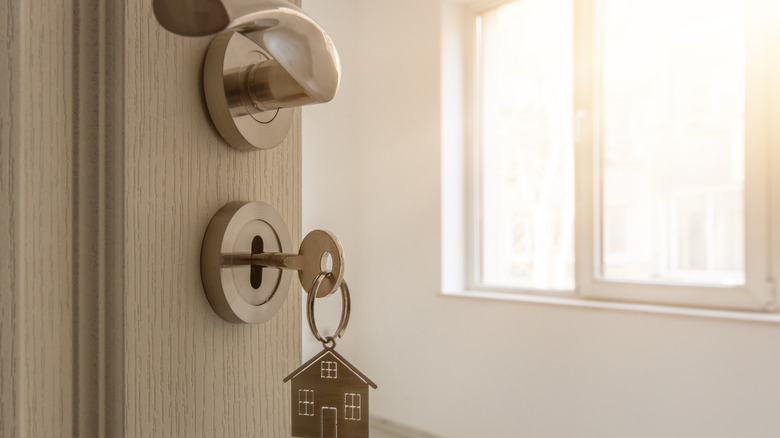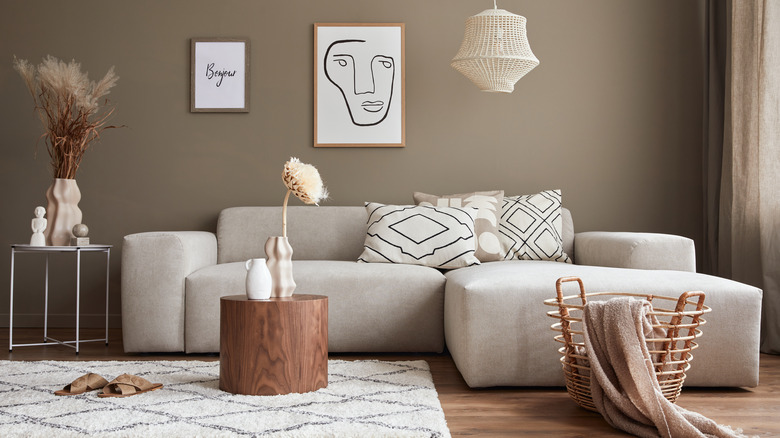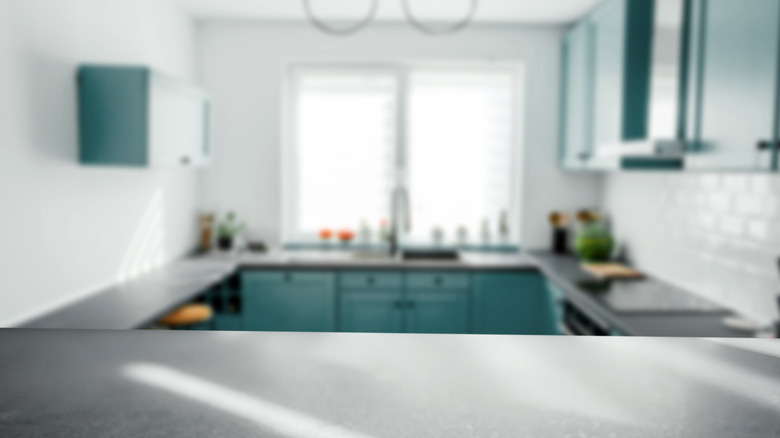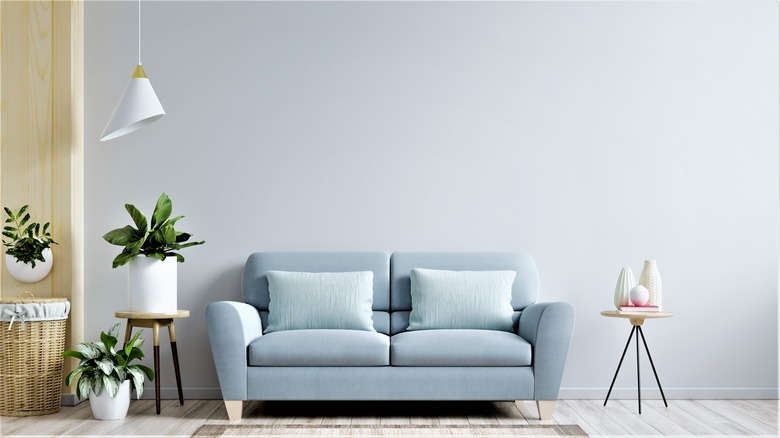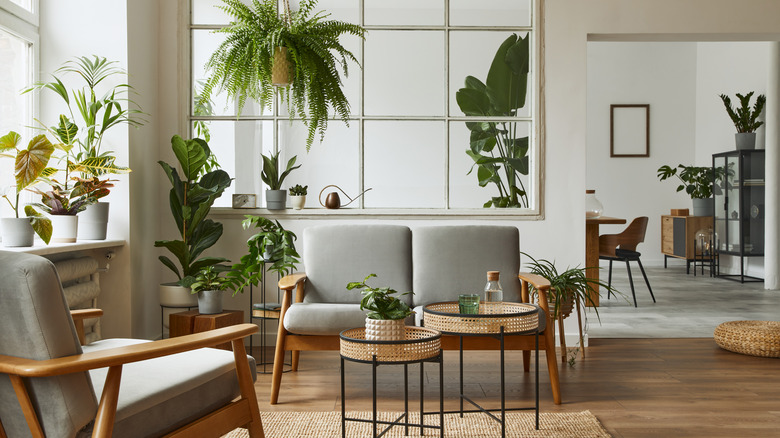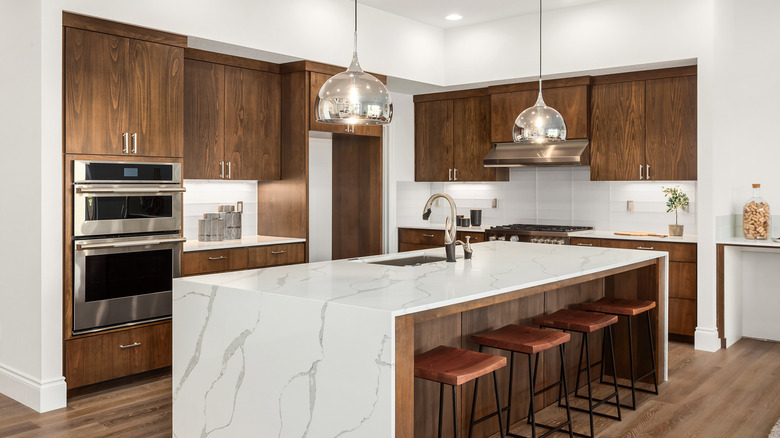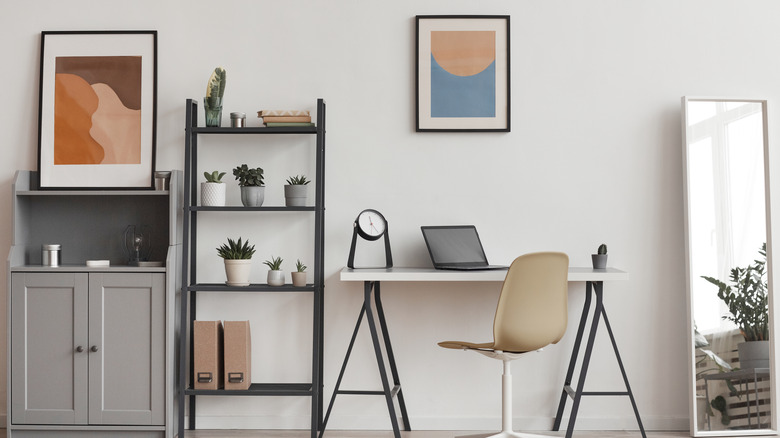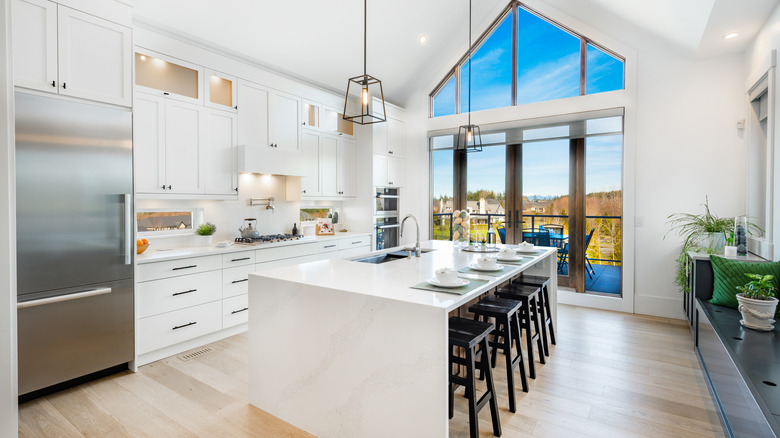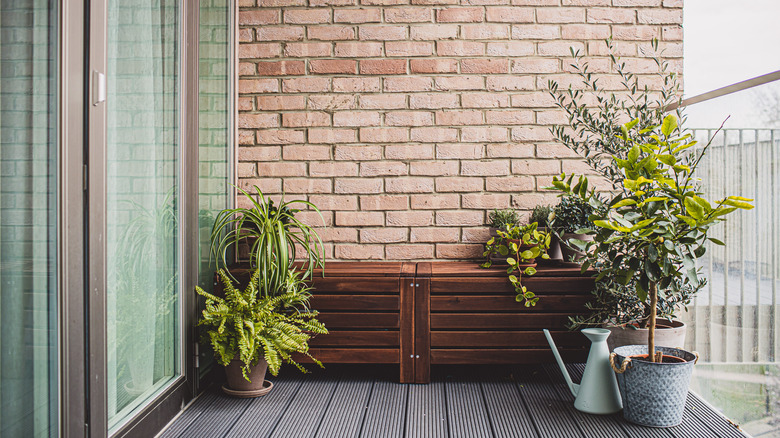How To Get Started On A Home Design Vision Board
Reimagining a home takes dedication and planning. The use of a vision board is a great way to streamline the process of building toward a new decorative design throughout your home or as a means of creating the perfect home addition, as pointed out by Martha Stewart.
A vision board is a simple tool, but one that offers a wonderful springboard toward the ultimate goal of your home redesign. Intuitive tools like Canva can help you collect images and other elements that can be added to the vision board, according to The Latina Next Door. Canva and offline programs like PowerPoint make for a great organizational asset that helps keep all your vision board slides in a single location that's easy to access and make changes to. Although, a paper format can also be useful for a more tactile approach.
Vision boards help you make sense of the nebulous thoughts that often float around while thinking through a home design change. This approach offers a tangible means of building a visual design mockup, and with a few slides dedicated to your ideas, you can quickly and effectively compare room design ideas or investigate how features of adjacent rooms might pair with one another.
Start early on your vision board journey
The sooner you begin to think about the vision for your redesign, the better. Many homeowners begin to think about the design elements of their new addition or remodeled kitchen or living room after the build has already begun. This condenses the time allowed for you to make stylistic additions to the space, whether in the actual build (for instance with the inclusion of majestic crown molding around the room) or in the furniture and decorations that are added to finish off the room's atmosphere.
According to Martha Stewart, starting as early as you can on the vision board will help make the project run smoother. An early start to the design elements that will complement any rebuilding (or new building) can make all the difference when trying to tie a room together and infuse your own unique personality into the space.
A vision board is all about finding and cataloging inspiration, so the longer you spend on this part of the project, the more complete your vision for the room will become. As a result, more time allotted to the design and theme often translates into greater happiness and satisfaction with the finished product.
Think about the things you love and the things you dislike about your current space
Taking inspiration from as many sources as you can is always a good idea when thinking through a redesign. Martha Stewart also offers great advice when it comes to finding inspiration and a new look and feel, noting that inspiration is truly everywhere these days. With the incredible power of the internet, you can find millions of images that catalog unique and interesting home décor ideas.
One thing that can be immensely helpful is a comparison with your existing home layout and design. If you are struggling to parse all the great ideas that you are finding in your search, stacking items, furniture, and design elements against your existing space can help you figure out the things you enjoy about your current setup as well as those that are bothersome or don't support your routine very well.
Often, some of the design features of your property will make sense to keep or recreate in the new space while others are definitely headed for the chopping block. Start with your existing designs to help facilitate an understanding of what you are unhappy with and want to change.
Define the goals of your redesign
It's also a good idea to think about your goals early on in the redesign, as per Louise Bartlett. Visualizing what you are looking for in the rebuild or reimagination of your home's features is what this project is all about, but without some clear-cut goals in mind, it can be hard to pin down exactly what you are trying to accomplish.
If you're in the midst of a kitchen remodel, for instance, you might want to consider why you are approaching this area of the home in particular. Perhaps the family has drifted away from adventurous home-cooked meals even though you and your loved ones enjoy culinary experimentation. In this instance, a redesign that is aimed at supporting greater use of the cooking space (a centralized stovetop, easy access spice racks, a creative nook area for cookbooks, etc.) might be the perfect start for your vision board.
Begin with the broad strokes and then fine tune the details
Design Wizard notes that it's important to focus on a goal while designing a vision board. But you don't have to know exactly where you're headed when you first launch the design project. In fact, it's often helpful to start with the broad strokes when establishing a new vision board. This is particularly helpful for those who've never created one of these design tools before.
A vision board that features kitchen elements, for example, might begin with a few countertops of interest, a stove, and a refrigerator. These prominent additions make their appearance in every kitchen, so you know you'll need to incorporate them into the finished rebuild. With digital images and applications, you can add multiple pictures and then delete the ones you no longer need. So there's no harm in adding two or three fridge options in the early stages before homing in on the exact model that suits your space and needs.
Don't be afraid to get creative
Creativity is what this project is all about. A vision board allows you to chase after your most out there and imaginative thoughts about how to redesign your home. The use of a vision board provides you with a blank canvas that's perfect for wild ideas that spur ingenious home design elements.
The more creative you can be with the vision board, the better your finished product will turn out. The Homes I Have Made reports that building preliminary mockups that feature interesting color and décor combinations can help you decide on aspects that you like for the space and other elements that won't make the final cut. Getting creative with the project will give you the breathing room necessary to play around with design ideas until you find a blend of new inclusions that perfectly match your expectations. This goes for color schemes, decorative additions, and everything in between.
Let your search guide you toward answers and options
Using image collation resources is a great way to stumble upon some beautiful additions to your vision board. With the wealth of resources out there, you can let your search guide the process, taking inspiration from the things you find along the way that make an impact on you. Design Wizard names Pinterest, PikWizard, and even Google Image Search as fantastic places to begin your hunt for vision board inclusions.
These resources offer a powerful way to investigate elements that are typically found across the home, but they also provide a great opportunity to allow your search parameters to guide future finds. Saving images that spark interest in you is a must, but you may want to consider following the links attached to these images and investigating more options or similar pieces on the pages that you're directed to.
Falling down the rabbit hole may be something to avoid during other research endeavors, but when it comes to building a vision board for your home redesign, the farther afield you end up, the better your vision board will become.
Search for completed vision boards put together by others
Another great approach to the project is one that involves looking through others' boards. People make vision boards and post them on social media, Pinterest, and other places every day. Additionally, many influencers in the design and décor worlds will post great content on a regular basis designed to help their followers make the most of their homes.
Seeking out other, completed vision boards for inspiration can help get you started if you are lacking a direction or ideas for a theme or color scheme. Martha Stewart suggests that inspiration can come from anything, and inspiring designs and motivational content exist all around you. Existing vision boards can offer a kick start for your creative juices.
Many people are approaching the vision board building process for the first time and won't have a clear idea of what they are looking to create. With the template of a pro's prebuilt vision board in a window on your desktop (or printed out for easy reference), you can take pieces from wherever inspiration strikes and assemble your board in the same manner as your reference point.
Have confidence in your board and the project
Lastly, confidence is a key resource that many people often forget about. It can be easy to get halfway through a vision board and lose confidence in the picture that's coming together. It's important to remember that a vision board is just that: With this planning tool, you're able to compile design and décor elements in a way that can help you visualize the physical output. Instead of having to buy expensive pieces and hope they fit together, a vision board helps you craft a visual representation of the items and features.
Maintaining confidence in the exercise is crucial as well as remembering that you don't have to keep to the vision board's end product when actually building out the room (via Martha Stewart). Likewise, you can change aspects of the board or even start completely from scratch at any time. Maintaining confidence in the endeavor and keeping an open mind are essential when approaching any home redesign, and a vision board can help manage these two core components.
